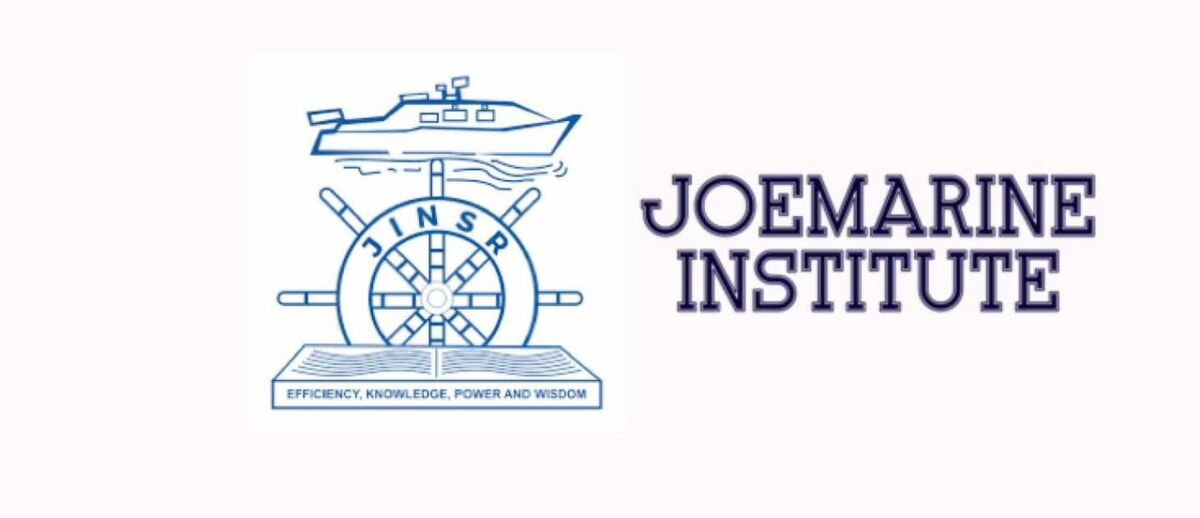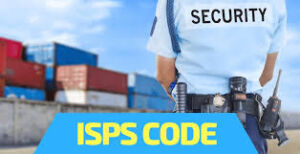ND NAUTICAL SCIENCE
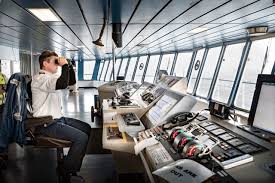
ND (National Diploma) Nautical Science Course Overview
The National Diploma (ND) in Nautical Science provides essential training for individuals seeking to pursue a career in maritime navigation and ship management. This course is typically offered by maritime academies and technical institutions, preparing students for roles on board ships and in maritime operations.
Objectives
- Equip students with the skills and knowledge required for effective ship navigation and management.
- Prepare graduates for roles as deck officers and other maritime positions.
- Ensure compliance with international maritime standards and regulations.
Course Content
-
Introduction to Nautical Science
- Overview of maritime industry and career opportunities.
- Basics of ship operations and terminology.
- Introduction to maritime laws and conventions.
-
Navigation
- Principles of marine navigation.
- Use of navigation tools such as compasses, sextants, and GPS.
- Chart work and plotting courses.
- Piloting and coastal navigation.
-
Ship Handling and Maneuvering
- Techniques for safe and efficient ship handling.
- Manoeuvring in various conditions and situations.
- Understanding ship stability and trim.
-
Meteorology and Oceanography
- Basics of meteorology and its impact on navigation.
- Understanding weather patterns and forecasting.
- Oceanographic principles and their relevance to navigation.
-
Maritime Safety and Survival
- Shipboard safety procedures and emergency protocols.
- Use of life-saving appliances and equipment.
- Fire prevention and firefighting on board.
-
Cargo Handling and Stowage
- Principles of cargo handling and securing.
- Understanding ship stability and loading calculations.
- Regulations and best practices for safe cargo operations.
-
International Regulations and Law
- Familiarization with international maritime regulations (SOLAS, COLREGs).
- Understanding legal responsibilities and documentation.
- Shipboard administrative procedures.
-
Communication and Watchkeeping
- Effective communication skills for maritime operations.
- Principles of watchkeeping and bridge operations.
- Use of communication equipment (VHF, GMDSS).
-
Marine Engineering Basics
- Introduction to marine propulsion systems.
- Basic maintenance and operational procedures for machinery.
- Understanding engine room functions and duties.
-
Maritime Leadership and Management
- Leadership skills and team management on board.
- Navigational watchkeeping duties and responsibilities.
- Decision-making and crisis management.
Course Duration and Certification
- Duration: Typically 2 years.
- Certification: Upon successful completion, students receive a National Diploma in Nautical Science.
Importance
- Career Preparation: Prepares graduates for careers as deck officers, navigation officers, and other maritime roles.
- Safety and Compliance: Ensures understanding of safety protocols and regulatory compliance.
- Further Education: Provides a foundation for advanced maritime studies or certifications, such as the Officer of the Watch (OOW) qualification.
The ND in Nautical Science course equips students with the comprehensive skills needed to navigate and manage ships effectively, contributing to their readiness for a career in the maritime industry.
- A minimum score of 100 in JAMB.
- Minimum of five credits in relevant subject in not more than two sittings. Subjects are: Mathematics, English, Physics, Geography and Chemistry.
- Duration: 2 years
REGISTRATION
- Register via our Admissions page or
- Visit our office at Plot 10, 39th Street, DDPA Housing Estate, Ugborikoko Effurun-Warri, Delta State.
MARINE METEOROLOGY & COASTAL MANAGEMENT
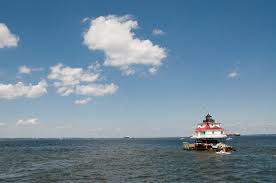
Marine Meteorology & Coastal Management Course Overview
The Marine Meteorology & Coastal Management course provides specialized training in understanding and managing marine and coastal environments, focusing on weather patterns, oceanographic conditions, and coastal resource management. This course prepares graduates for roles in environmental management, coastal planning, and marine meteorology.
Objectives
- Equip students with knowledge of marine meteorology and its impact on coastal environments.
- Develop skills in managing and protecting coastal resources and ecosystems.
- Prepare graduates for careers in environmental consulting, coastal management, and meteorological services.
Course Content
-
Introduction to Marine Meteorology
- Basics of atmospheric science and meteorology.
- Weather patterns and phenomena affecting marine environments.
- Use of meteorological data and tools in marine forecasting.
-
Oceanography
- Fundamentals of oceanographic processes and marine systems.
- Interaction between ocean currents, tides, and weather.
- Impact of oceanographic conditions on coastal areas.
-
Coastal Processes and Dynamics
- Coastal landforms and processes (erosion, sedimentation).
- Coastal dynamics and interactions with marine systems.
- Effects of natural events (storms, sea-level rise) on coastal regions.
-
Marine Climate Change
- Impact of climate change on marine and coastal environments.
- Sea-level rise, ocean acidification, and temperature changes.
- Adaptation and mitigation strategies for climate-related impacts.
-
Coastal Management
- Principles of integrated coastal zone management (ICZM).
- Coastal resource management and sustainable practices.
- Policy frameworks, regulations, and planning for coastal areas.
-
Marine Environmental Protection
- Environmental impact assessments and management practices.
- Conservation of marine biodiversity and habitats.
- Pollution control and marine waste management.
-
Coastal Risk and Disaster Management
- Risk assessment and management of coastal hazards (storms, tsunamis).
- Disaster preparedness and response strategies.
- Community resilience and recovery planning.
-
Data Analysis and Modeling
- Use of data and models for marine and coastal studies.
- Statistical analysis and interpretation of meteorological and oceanographic data.
- Application of modeling tools for forecasting and planning.
-
Fieldwork and Practical Applications
- Hands-on experience with meteorological and oceanographic instruments.
- Coastal field surveys and data collection.
- Case studies and practical applications in coastal management.
-
Policy and Governance
- Understanding policies and governance structures related to coastal management.
- Stakeholder engagement and policy development.
- International conventions and agreements on marine and coastal management.
Course Duration and Certification
- Duration: Typically 1 to 2 years, depending on the program and institution.
- Certification: Upon successful completion, students receive a diploma or degree in Marine Meteorology & Coastal Management.
Importance
- Specialized Knowledge: Provides in-depth understanding of marine meteorology and coastal processes.
- Career Opportunities: Prepares graduates for roles in environmental management, coastal planning, meteorological services, and research.
- Environmental Impact: Equips professionals to address climate change, manage coastal resources, and protect marine environments.
The Marine Meteorology & Coastal Management course offers a comprehensive education in managing and understanding marine and coastal environments, equipping students with the skills needed to tackle environmental challenges and contribute to sustainable coastal development.
- A minimum score of 100 in JAMB.
- Minimum of five credits in relevant subject in not more than two sittings. Subjects are: Mathematics, English, Physics, Geography and Chemistry/Biology.
- Duration: 2 years
REGISTRATION
- Register via our Admissions page or
- Visit our office at Plot 10, 39th Street, DDPA Housing Estate, Ugborikoko Effurun-Warri, Delta State.
MARITIME TRANSPORT & BUSINESS MANAGEMENT
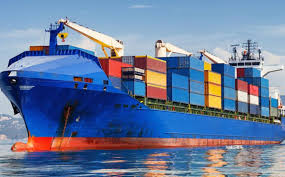
Maritime Transport & Business Management Course Overview
The Maritime Transport & Business Management course is designed to equip students with the skills and knowledge needed for effective management and operations within the maritime industry. This course combines maritime transport fundamentals with business management principles, preparing graduates for roles in shipping companies, port authorities, and logistics firms.
Objectives
- Provide a comprehensive understanding of maritime transport systems and logistics.
- Develop management skills relevant to the maritime and shipping industries.
- Prepare graduates for strategic roles in maritime transport and business operations.
Course Content
-
Introduction to Maritime Transport
- Overview of the maritime industry and global shipping.
- Structure and operations of shipping companies and port facilities.
- Key maritime trade routes and economic significance.
-
Maritime Logistics and Supply Chain Management
- Principles of logistics and supply chain management.
- Role of maritime transport in global supply chains.
- Cargo handling, warehousing, and distribution.
-
Ship Management and Operations
- Basics of ship operations and management.
- Maintenance and repair of ships.
- Fleet management and operational efficiency.
-
Maritime Law and Regulations
- Overview of international maritime laws and conventions (SOLAS, MARPOL).
- Regulatory frameworks and compliance requirements.
- Understanding contracts, insurance, and liability.
-
Port and Terminal Management
- Functions and operations of ports and terminals.
- Port infrastructure, cargo handling equipment, and logistics.
- Strategies for optimizing port operations and efficiency.
-
Maritime Business and Finance
- Financial management and accounting in the maritime sector.
- Business strategies and economic principles in shipping.
- Investment, risk management, and financial planning.
-
Maritime Safety and Environmental Management
- Safety management systems and practices in maritime transport.
- Environmental regulations and sustainability practices.
- Risk assessment and emergency response planning.
-
Marketing and Strategic Management
- Marketing principles and strategies for maritime businesses.
- Strategic planning and decision-making in the maritime industry.
- Competitive analysis and market trends.
-
Human Resource Management
- HR practices and management in the maritime sector.
- Recruitment, training, and development of maritime personnel.
- Employee relations and organizational behavior.
-
Technology and Innovation in Maritime Transport
- Impact of technology on maritime operations and management.
- Innovations in shipping, logistics, and port operations.
- Use of data analytics and digital tools in maritime business.
Course Duration and Certification
- Duration: Typically 2 to 4 years, depending on the institution and program structure.
- Certification: Upon successful completion, students receive a diploma or degree in Maritime Transport & Business Management.
Importance
- Industry Preparation: Equips graduates with the skills needed for management and operational roles in the maritime industry.
- Business Skills: Combines maritime knowledge with business management skills, enhancing career prospects.
- Career Opportunities: Prepares graduates for roles in shipping companies, port authorities, logistics firms, and maritime consultancy.
The Maritime Transport & Business Management course provides a solid foundation in both maritime operations and business management, preparing students for a successful career in the global maritime industry.
- A minimum score of 100 in JAMB.
- Minimum of five credits in relevant subject in not more than two sittings. Subjects are: Mathematics, English, Geography, Commerce and Economics.
- Duration: 2 years
REGISTRATION
- Register via our Admissions page or
- Visit our office at Plot 10, 39th Street, DDPA Housing Estate, Ugborikoko Effurun-Warri, Delta State.
ND COMPUTER SCIENCE
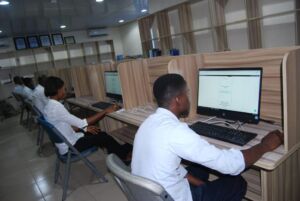
ND (National Diploma) Computer Science Course Overview
The National Diploma (ND) in Computer Science provides students with foundational knowledge and practical skills in computing and information technology. This course is typically offered by polytechnics and technical institutions and prepares graduates for careers in the IT industry or further studies.
Objectives
- Develop a strong foundation in computer science principles.
- Equip students with practical skills in programming, software development, and system management.
- Prepare graduates for entry-level positions in the IT industry or for further academic pursuits.
Course Content
-
Introduction to Computer Science
- Overview of computer systems and components.
- Basic concepts of hardware and software.
- History and evolution of computers.
-
Programming Fundamentals
- Basics of programming languages (e.g., Python, Java, C++).
- Writing, testing, and debugging code.
- Introduction to algorithms and data structures.
-
Mathematics for Computer Science
- Discrete mathematics.
- Linear algebra and calculus.
- Probability and statistics.
-
Database Management Systems
- Introduction to databases and database management systems (DBMS).
- SQL and database querying.
- Database design and normalization.
-
Software Engineering
- Software development life cycle (SDLC).
- Principles of software design and testing.
- Project management and documentation.
-
Computer Networks
- Fundamentals of networking.
- Network topologies, protocols, and architectures.
- Basics of network security.
-
Operating Systems
- Functions and types of operating systems.
- Process management, memory management, and file systems.
- Introduction to Unix/Linux and Windows OS.
-
Web Development
- Basics of web design and development.
- HTML, CSS, and JavaScript.
- Introduction to web frameworks and content management systems (CMS).
-
Data Structures and Algorithms
- Advanced data structures (trees, graphs, hash tables).
- Algorithm design and analysis.
- Sorting and searching algorithms.
-
Information Systems
- Introduction to information systems and their role in organizations.
- Systems analysis and design.
- Management information systems (MIS).
Course Duration and Certification
- Duration: Typically 2 years.
- Certification: Upon successful completion, students receive a National Diploma in Computer Science.
Importance
- Skill Development: Provides essential skills for a career in IT.
- Career Opportunities: Prepares graduates for roles such as software developer, systems analyst, network administrator, and database manager.
- Further Education: Lays the groundwork for advanced studies in computer science or related fields.
The ND in Computer Science course equips students with the knowledge and skills needed to succeed in the rapidly evolving field of information technology.
- A minimum score of 100 in JAMB.
- Minimum of five credits in relevant subject in not more than two sittings. Subjects are: Mathematics, English, Physics, Chemistry and Biology/Further mathematics
- Duration: 2 years
REGISTRATION
- Register via our Admissions page or
- Visit our office at Plot 10, 39th Street, DDPA Housing Estate, Ugborikoko Effurun-Warri, Delta State.
BASIC MANDATORY(STCW)
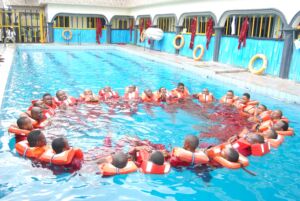
The basic mandatory courses for seafarers are designed to ensure that all personnel working on ships have the necessary skills and knowledge to handle emergencies, maintain safety, and operate effectively. These courses are required under the STCW Convention and include the following:
1. Personal Survival Techniques (PST)
- Objective: Equip seafarers with the skills needed to survive at sea in the event of abandonment.
- Content:
- Use of life-saving appliances and survival crafts.
- Survival at sea techniques.
- Personal safety procedures during emergencies.
- Use of personal protective equipment.
2. Fire Prevention and Fire Fighting (FPFF)
- Objective: Train seafarers in fire prevention, firefighting techniques, and the use of firefighting equipment.
- Content:
- Fire chemistry and hazards.
- Firefighting procedures and methods.
- Use of firefighting equipment, including extinguishers and hoses.
- Firefighting organization and emergency plans.
- Practical exercises in firefighting.
3. Elementary First Aid (EFA)
- Objective: Provide basic first aid knowledge and skills to handle medical emergencies on board.
- Content:
- Basic first aid principles.
- Resuscitation techniques (CPR).
- Treatment of wounds, burns, fractures, and other injuries.
- Management of medical emergencies such as shock and unconsciousness.
4. Personal Safety and Social Responsibilities (PSSR)
- Objective: Familiarize seafarers with safe working practices and develop awareness of safety and social responsibilities.
- Content:
- Safe working practices and accident prevention.
- Environmental protection measures.
- Understanding and complying with emergency procedures.
- Effective communication and teamwork on board.
- Rights and responsibilities of seafarers.
5. Proficiency in Security Awareness (PSA)
- Objective: Ensure seafarers can contribute to the security of the ship and understand the importance of maintaining security vigilance.
- Content:
- Security threats and patterns.
- Recognition of security risks and suspicious activities.
- Methods to maintain security awareness.
- Reporting security incidents.
Course Duration and Certification
- Duration: Each course typically lasts between one to five days, depending on the training provider and specific course requirements.
- Certification: Upon successful completion of each course, seafarers receive a certificate of proficiency. These certificates are essential for obtaining the STCW certification required to work on board ships.
Importance
- Compliance: Mandatory for all seafarers to comply with international maritime regulations.
- Safety: Enhances personal and crew safety, ensuring readiness to handle emergencies.
- Career Advancement: Necessary for career progression and obtaining higher responsibilities on board.
These basic mandatory courses provide a foundation for seafarers, ensuring they are prepared for the challenges of working at sea and capable of maintaining high safety standards.
The following requirements are compulsory for class attendance and certificate approval.
- Seafarer’s Medical fitness certificate.
- 2 Passport photograph.
- Valid means of Identification (NIN, INTERNATIONAL PASSPORT, VOTERS CARD SEAMAN BOOKLET ETC.)
- Receipts of payments
- NEW 5DAYS
- RENEWAL 2DAYS
REGISTRATION
- Visit our office at Plot 10, 39th Street, DDPA Housing Estate, Ugborikoko Effurun-Warri, Delta State.
NOTE: Payment is done only at our office, and payment validates registration.
EFFICIENT DECK HAND(EDH)
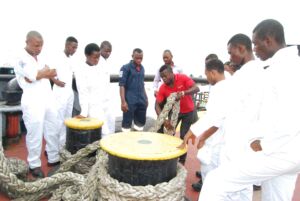
Efficient Deck Hand (EDH) Course Overview
The Efficient Deck Hand (EDH) course is a mandatory training program designed for seafarers aiming to enhance their skills and knowledge for efficient and safe operations on deck. This course is a crucial step for those aspiring to progress in their maritime careers, particularly for those working towards obtaining an Able Seafarer Deck certificate.
Objectives
- Equip seafarers with the practical skills and theoretical knowledge required for efficient deck operations.
- Enhance safety awareness and operational competence in various deck-related tasks.
Content
-
Ropework and Knots
- Types of ropes and their uses.
- Techniques for splicing, whipping, and knot-tying.
- Care and maintenance of ropes and wires.
-
Mooring and Anchoring Operations
- Procedures for safe mooring and unmooring.
- Handling mooring lines and equipment.
- Anchoring techniques and anchor handling.
-
Cargo Handling and Stowage
- Safe handling and securing of cargo.
- Understanding ship stability and cargo stowage principles.
- Use of lifting equipment and gear.
-
Deck Maintenance
- Maintenance of ship’s structure and fittings.
- Painting, cleaning, and corrosion control.
- Use of tools and safety equipment.
-
Watchkeeping Duties
- Principles of effective watchkeeping.
- Bridge watchkeeping procedures and responsibilities.
- Communication and reporting during watch.
-
Safety and Emergency Procedures
- Understanding shipboard safety regulations and procedures.
- Emergency drills and procedures, including man overboard and fire drills.
- Use of safety equipment and personal protective gear.
Course Duration and Certification
- Duration: Typically lasts between 5 to 10 days, depending on the training provider.
- Certification: Upon successful completion, participants receive an Efficient Deck Hand (EDH) certificate, which is a prerequisite for the Able Seafarer Deck certificate under the STCW Convention.
Importance
- Compliance: Meets the requirements of the STCW Convention for deck personnel.
- Safety: Enhances safety and efficiency in deck operations, reducing the risk of accidents.
- Career Advancement: Essential for career progression to higher ranks, such as Able Seafarer Deck and beyond.
The EDH course ensures that seafarers are proficient in fundamental deck operations, contributing to the overall safety and efficiency of maritime operations.
The following requirements are compulsory for class attendance and certificate approval.
- Seafarer’s Medical fitness certificate.
- Basic mandatory(STCW) Certificate.
- 2 Passport photograph.
- Valid means of Identification (NIN, INTERNATIONAL PASSPORT, VOTERS CARD SEAMAN BOOKLET ETC.)
- Receipts of payments
- 5 DAYS.
REGISTRATION
- Visit our office at Plot 10, 39th Street, DDPA Housing Estate, Ugborikoko Effurun-Warri, Delta State.
NOTE: Payment is done only at our office, and payment validates registration.
MOTORMAN
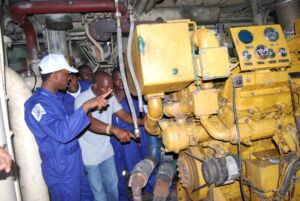
Motorman Course Overview
The Motorman course prepares seafarers for roles in the engine room, focusing on the skills and knowledge needed for effective operation and maintenance of machinery on board a ship.
Objectives
- Equip seafarers with practical skills and theoretical knowledge for engine room operations.
- Ensure safe and efficient maintenance and operation of ship machinery.
Course Content
-
Basic Engineering Knowledge
- Marine engines and their components.
- Diesel engines and other propulsion systems.
- Auxiliary machinery such as pumps, compressors, and generators.
-
Operation and Maintenance of Machinery
- Routine maintenance tasks.
- Lubrication and cooling systems.
- Fuel systems and bunkering procedures.
-
Safety Procedures
- Engine room safety protocols and hazard awareness.
- Use of personal protective equipment (PPE).
- Fire prevention and firefighting.
- Emergency procedures and drills.
-
Tools and Equipment
- Use and care of hand and power tools.
- Workshop equipment and machine tools.
- Safe handling and storage of tools.
-
Watchkeeping Duties
- Engine room watchkeeping principles.
- Monitoring and recording engine parameters.
- Troubleshooting common engine problems.
- Communication and reporting during watch.
-
Electrical Knowledge
- Basics of marine electrical systems.
- Safe practices with electrical equipment.
- Maintenance of batteries and electrical components.
- Understanding electrical schematics.
Course Duration and Certification
- Duration: Typically 5 to 10 days.
- Certification: Successful completion awards a Motorman certificate, often required for engine room ratings under the STCW Convention.
Importance
- Compliance: Meets STCW requirements for engine room personnel.
- Safety: Enhances safe and efficient operation of engine room machinery.
- Career Advancement: Provides foundational skills for career progression within the engineering department, such as advancing to Oiler or Assistant Engineer.
The Motorman course ensures seafarers are proficient in essential engine room operations, contributing to overall maritime safety and efficiency.
The following requirements are compulsory for class attendance and certificate approval.
- Seafarer’s Medical fitness certificate.
- Basic mandatory(STCW) Certificate.
- 2 Passport photograph.
- Valid means of Identification (NIN, INTERNATIONAL PASSPORT, VOTERS CARD SEAMAN BOOKLET ETC.)
- Receipts of payments
- 5 DAYS.
REGISTRATION
- Visit our office at Plot 10, 39th Street, DDPA Housing Estate, Ugborikoko Effurun-Warri, Delta State.
NOTE: Payment is done only at our office, and payment validates registration.
INTERNATIONAL SHIP AND PORT FACILITY SECURITY (ISPS)
International Ship and Port Facility Security (ISPS) Course Overview
The International Ship and Port Facility Security (ISPS) course is designed to provide maritime professionals with the knowledge and skills necessary to implement and manage security measures for ships and port facilities. This course is essential for those involved in maritime security, including security officers, port facility managers, and ship operators.
Objectives
- Equip participants with a thorough understanding of the ISPS Code and its requirements.
- Develop skills to assess and manage security risks in maritime environments.
- Prepare professionals to implement and oversee security plans for ships and port facilities.
Course Content
-
Introduction to Maritime Security
- Overview of the ISPS Code and its objectives.
- Roles and responsibilities under the ISPS Code.
- International maritime security regulations and guidelines.
-
Security Assessments and Planning
- Conducting security assessments for ships and port facilities.
- Developing and implementing security plans and procedures.
- Identifying and mitigating security risks and vulnerabilities.
-
Ship Security
- Security measures for ships, including access control and surveillance.
- Ship security plan development and implementation.
- Security drills and exercises for ship crews.
-
Port Facility Security
- Security measures for port facilities, including perimeter security and access control.
- Port facility security plan development and implementation.
- Coordination with local law enforcement and security agencies.
-
Security Equipment and Technology
- Use of security equipment and technology (e.g., CCTV, alarms).
- Maintenance and operation of security systems.
- Integration of security technology into security plans.
-
Emergency Response and Incident Management
- Responding to security incidents and breaches.
- Coordination with emergency services and other stakeholders.
- Crisis management and communication strategies.
-
Training and Drills
- Training requirements for ship and port facility personnel.
- Conducting security drills and exercises.
- Evaluating and improving security procedures based on drill outcomes.
-
Legal and Regulatory Compliance
- Understanding legal obligations under the ISPS Code and other regulations.
- Ensuring compliance with international and national security regulations.
- Handling documentation and reporting requirements.
-
Security Management and Leadership
- Security management principles and best practices.
- Leadership skills for security officers and facility managers.
- Effective communication and coordination within security teams.
-
Case Studies and Practical Applications
- Analysis of real-world security incidents and lessons learned.
- Practical exercises and simulations to apply security knowledge.
- Review and discussion of current trends and challenges in maritime security.
Course Duration and Certification
- Duration: Typically 3 to 5 days, depending on the institution and course structure.
- Certification: Upon successful completion, participants receive a certification in International Ship and Port Facility Security, indicating their competence in maritime security management.
Importance
- Compliance: Ensures adherence to the ISPS Code and international maritime security standards.
- Risk Management: Enhances the ability to assess and manage security risks effectively.
- Career Advancement: Provides qualifications for roles in maritime security and port facility management.
The ISPS course is crucial for maritime professionals responsible for safeguarding ships and port facilities, ensuring they are equipped with the necessary skills to manage and implement effective security measures in compliance with international regulations.
The following requirements are compulsory for class attendance and certificate approval.
- Seafarer’s Medical fitness certificate.
- Basic mandatory(STCW) Certificate.
- 2 Passport photograph.
- Valid means of Identification (NIN, INTERNATIONAL PASSPORT, VOTERS CARD SEAMAN BOOKLET ETC.)
- Receipts of payments
- OFFICER 2 DAYS
- RATINGS 1 DAY
REGISTRATION
- Visit our office at Plot 10, 39th Street, DDPA Housing Estate, Ugborikoko Effurun-Warri, Delta State.
NOTE: Payment is done only at our office, and payment validates registration.
BASIC OIL TANKER FAMILIARIZATION (OTF)

The Oil Tanker Familiarization course is designed to provide mariners with the fundamental knowledge and skills required to work on oil tankers safely and efficiently. This course covers various aspects of oil tanker operations, safety protocols, and regulatory requirements. Here’s an overview of the key components typically included in an Oil Tanker Familiarization course:
Course Objectives
- Understand the basic operations and characteristics of oil tankers.
- Gain knowledge of safety practices and emergency response procedures.
- Learn about pollution prevention and environmental protection measures.
- Familiarize with international regulations and standards governing oil tanker operations.
Key Topics Covered
1. Introduction to Oil Tankers
- Types and sizes of oil tankers.
- General layout and design of oil tankers.
- Terminology and definitions specific to oil tanker operations.
2. Cargo Handling and Operations
- Principles of oil cargo handling.
- Loading and unloading procedures.
- Tank cleaning and gas freeing.
- Use of cargo handling equipment and systems.
3. Safety and Fire Prevention
- Fire hazards associated with oil tankers.
- Firefighting systems and equipment on oil tankers.
- Fire prevention measures and protocols.
4. Pollution Prevention and Environmental Protection
- Sources of pollution from oil tankers.
- Procedures for preventing oil spills and pollution.
- Use of oil spill response equipment.
- Compliance with MARPOL regulations and other environmental standards.
5. Tank Atmosphere Control
- Inert gas systems and their operation.
- Ventilation and gas freeing procedures.
- Monitoring and controlling tank atmospheres.
6. Health and Safety
- Personal protective equipment (PPE) and its use.
- Health hazards associated with oil cargoes.
- Safe work practices and safety culture on oil tankers.
7. Emergency Procedures
- Emergency response plans and drills.
- Procedures for dealing with oil spills, fires, and other emergencies.
- Use of emergency equipment and systems.
8. Regulatory Framework
- International regulations and conventions governing oil tanker operations.
- Flag state and port state control requirements.
- Certification and documentation required for oil tankers.
9. Case Studies and Practical Exercises
- Analysis of past oil tanker incidents and accidents.
- Lessons learned and best practices.
- Practical exercises and simulations to reinforce learning.
Practical Training Components
- Simulations and Drills: Hands-on practice with cargo handling, emergency response, and pollution prevention.
- Equipment Familiarization: Training on the use and maintenance of tanker-specific equipment and systems.
- Scenario-Based Training: Real-life scenarios to practice safe operations and emergency response.
Learning Outcomes
Upon completion of the Oil Tanker Familiarization course, participants should be able to:
- Safely perform basic operations on an oil tanker.
- Understand and implement safety and pollution prevention measures.
- Respond effectively to emergencies involving oil cargoes.
- Comply with international regulations and standards for oil tanker operations.
- Promote a safety culture and environmental stewardship on board.
Certification
Participants who successfully complete the course typically receive a certificate of completion, which may be a prerequisite for working on oil tankers and for further specialized training.
Conclusion
The Oil Tanker Familiarization course is essential for mariners who intend to work on oil tankers. It provides the foundational knowledge and skills necessary to operate safely and efficiently while ensuring compliance with regulatory requirements. The course emphasizes safety, environmental protection, and the importance of adhering to best practices in tanker operations.
The following requirements are compulsory for class attendance and certificate approval.
- Seafarer’s Medical fitness certificate.
- Basic mandatory(STCW) Certificate.
- 2 Passport photograph.
- Valid means of Identification (NIN, INTERNATIONAL PASSPORT, VOTERS CARD SEAMAN BOOKLET ETC.)
- Receipts of payments
- NEW 3DAYS
- RENEWAL 2DAYS
REGISTRATION
- Visit our office at Plot 10, 39th Street, DDPA Housing Estate, Ugborikoko Effurun-Warri, Delta State.
NOTE: Payment is done only at our office, and payment validates registration.
RATING FORMING PART OF NAVIGATIONAL WATCH
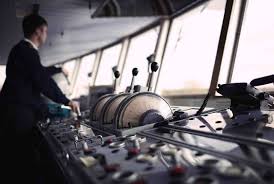
The Rating Forming Part of a Navigational Watch (RFPNW) course is designed to train seafarers to become effective members of a bridge watchkeeping team. This course provides the necessary knowledge and skills required to support the navigational officer and ensure the safe operation of the vessel. Here’s an overview of the key components typically included in an RFPNW course:
Course Objectives
- Equip trainees with the skills and knowledge to perform navigational watch duties.
- Ensure understanding of maritime safety procedures and regulations.
- Develop competence in using navigational equipment and performing lookout duties.
- Foster effective communication and teamwork on the bridge.
Key Topics Covered
1. Introduction to Watchkeeping Duties
- Roles and responsibilities of a rating in navigational watch.
- Importance of adhering to watchkeeping standards and practices.
- Overview of bridge team operations and hierarchy.
2. Navigation and Lookout Responsibilities
- Principles of navigation and the role of a lookout.
- Maintaining a proper lookout by sight and hearing.
- Reporting observations and responding to navigational instructions.
3. Navigational Equipment
- Basic operation and use of bridge navigational equipment.
- Radar, GPS, ECDIS, and other electronic aids to navigation.
- Maintenance and care of navigational instruments.
4. Bridge Procedures and Practices
- Standard bridge procedures during different stages of navigation (e.g., open sea, coastal waters, port approaches).
- Understanding and following the International Regulations for Preventing Collisions at Sea (COLREGS).
- Communication protocols and the use of bridge communication systems.
5. Safety and Emergency Procedures
- Basic safety principles and emergency response protocols.
- Use of safety equipment, including life jackets and fire extinguishers.
- Procedures for man overboard, fire, and other emergencies.
6. Environmental Protection
- Understanding MARPOL regulations and the importance of pollution prevention.
- Procedures for handling and disposing of waste on board.
- Best practices for minimizing environmental impact.
7. Watchkeeping in Adverse Conditions
- Procedures for watchkeeping in poor visibility, heavy traffic, and adverse weather conditions.
- Recognizing and responding to hazards and potential risks.
8. Effective Communication and Teamwork
- Importance of clear and concise communication on the bridge.
- Techniques for effective teamwork and coordination with other crew members.
- Reporting procedures and maintaining an effective log.
9. Practical Training and Assessments
- Hands-on training in performing lookout duties and operating navigational equipment.
- Simulation exercises to practice watchkeeping scenarios and emergency responses.
- Assessments to evaluate competence and readiness for watchkeeping duties.
Practical Training Components
- On-the-Job Training: Supervised watchkeeping experience on board a vessel.
- Simulator Training: Use of bridge simulators to practice and refine skills in a controlled environment.
- Role-Playing Exercises: Scenarios to practice communication, teamwork, and emergency response.
Learning Outcomes
Upon completion of the RFPNW course, participants should be able to:
- Perform lookout duties effectively, maintaining a proper watch by sight and hearing.
- Operate and maintain bridge navigational equipment competently.
- Understand and follow standard bridge procedures and watchkeeping practices.
- Communicate effectively with the bridge team and other crew members.
- Respond appropriately to navigational instructions and emergency situations.
- Adhere to safety and environmental protection regulations.
Certification
Participants who successfully complete the RFPNW course typically receive a certificate of proficiency, which is a prerequisite for serving as a rating forming part of a navigational watch in accordance with the STCW (Standards of Training, Certification, and Watchkeeping) Convention.
Conclusion
The Rating Forming Part of a Navigational Watch course is essential for seafarers aspiring to be part of a bridge watchkeeping team. It ensures that participants are well-prepared to support the navigational officer, perform lookout duties, and contribute to the safe and efficient operation of the vessel. The course emphasizes practical training, adherence to safety standards, and effective communication, which are critical for successful watchkeeping.
The following requirements are compulsory for class attendance and certificate approval.
- Seafarer’s Medical fitness certificate.
- Basic mandatory(STCW) Certificate.
- 2 Passport photograph.
- Valid means of Identification (NIN, INTERNATIONAL PASSPORT, VOTERS CARD SEAMAN BOOKLET ETC.)
- Receipts of payments
- 10 DAYS.
REGISTRATION
- Visit our office at Plot 10, 39th Street, DDPA Housing Estate, Ugborikoko Effurun-Warri, Delta State.
NOTE: Payment is done only at our office, and payment validates registration.
RATING FORMING PART OF ENGINE WATCH
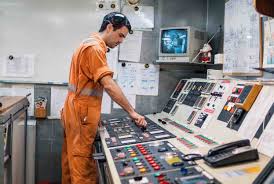
The Rating Forming Part of an Engine Watch (RFPEW) course is designed to train seafarers to competently assist in the operation and maintenance of the engine room and its associated systems. This course provides the necessary knowledge and skills required to support engineering officers and ensure the safe and efficient operation of the vessel’s machinery. Here’s an overview of the key components typically included in an RFPEW course:
Course Objectives
- Equip trainees with the skills and knowledge to perform engine room watchkeeping duties.
- Ensure understanding of engine room safety procedures and regulations.
- Develop competence in operating and maintaining engine room equipment.
- Foster effective communication and teamwork within the engineering department.
Key Topics Covered
1. Introduction to Engine Room Watchkeeping Duties
- Roles and responsibilities of a rating in an engine watch.
- Importance of adhering to watchkeeping standards and practices.
- Overview of engine room team operations and hierarchy.
2. Engine Room Equipment and Systems
- Types and functions of main and auxiliary machinery.
- Operation of pumps, compressors, boilers, and other essential equipment.
- Overview of engine controls and monitoring systems.
3. Basic Engineering Knowledge
- Principles of diesel engines, steam turbines, and other propulsion systems.
- Basic concepts of thermodynamics and fluid mechanics.
- Understanding lubrication, cooling, and fuel systems.
4. Maintenance and Repair
- Routine maintenance procedures for engine room equipment.
- Use of tools and equipment for minor repairs.
- Preventive maintenance practices to ensure machinery reliability.
5. Safety and Emergency Procedures
- Engine room safety protocols and best practices.
- Emergency response procedures, including fire, flooding, and equipment failure.
- Use of safety equipment, including personal protective equipment (PPE).
6. Pollution Prevention and Environmental Protection
- MARPOL regulations related to engine room operations.
- Procedures for handling and disposing of oil, bilge water, and other waste.
- Best practices for minimizing environmental impact.
7. Watchkeeping in Adverse Conditions
- Procedures for watchkeeping during rough weather, heavy traffic, and other challenging conditions.
- Recognizing and responding to hazards and potential risks.
8. Effective Communication and Teamwork
- Importance of clear and concise communication within the engine room team.
- Techniques for effective teamwork and coordination with other departments.
- Reporting procedures and maintaining an effective log.
9. Practical Training and Assessments
- Hands-on training in operating and maintaining engine room equipment.
- Simulation exercises to practice watchkeeping scenarios and emergency responses.
- Assessments to evaluate competence and readiness for engine room watchkeeping duties.
Practical Training Components
- On-the-Job Training: Supervised watchkeeping experience in an engine room.
- Simulator Training: Use of engine room simulators to practice and refine skills in a controlled environment.
- Role-Playing Exercises: Scenarios to practice communication, teamwork, and emergency response.
Learning Outcomes
Upon completion of the RFPEW course, participants should be able to:
- Perform engine room watchkeeping duties effectively.
- Operate and maintain engine room equipment competently.
- Understand and follow standard engine room procedures and watchkeeping practices.
- Communicate effectively with the engineering team and other crew members.
- Respond appropriately to engineering instructions and emergency situations.
- Adhere to safety and environmental protection regulations.
Certification
Participants who successfully complete the RFPEW course typically receive a certificate of proficiency, which is a prerequisite for serving as a rating forming part of an engine watch in accordance with the STCW (Standards of Training, Certification, and Watchkeeping) Convention.
Conclusion
The Rating Forming Part of an Engine Watch course is essential for seafarers aspiring to be part of an engine room watchkeeping team. It ensures that participants are well-prepared to support engineering officers, operate and maintain engine room equipment, and contribute to the safe and efficient operation of the vessel. The course emphasizes practical training, adherence to safety standards, and effective communication, which are critical for successful watchkeeping.
The following requirements are compulsory for class attendance and certificate approval.
- Seafarer’s Medical fitness certificate.
- Basic mandatory(STCW) Certificate.
- 2 Passport photograph.
- Valid means of Identification (NIN, INTERNATIONAL PASSPORT, VOTERS CARD SEAMAN BOOKLET ETC.)
- Receipts of payments
- 10 DAYS.
REGISTRATION
- Visit our office at Plot 10, 39th Street, DDPA Housing Estate, Ugborikoko Effurun-Warri, Delta State.
NOTE: Payment is done only at our office, and payment validates registration.
SHIP SECURITY OFFICER(SSO)

Ship Security Officer (SSO) Course Overview
The Ship Security Officer (SSO) course is designed to equip maritime professionals with the skills and knowledge necessary to oversee and manage ship security in compliance with the International Ship and Port Facility Security (ISPS) Code. This role is crucial for ensuring that ships are secure from threats and comply with international maritime security regulations.
Objectives
- Train participants to develop, implement, and maintain effective Ship Security Plans (SSPs).
- Ensure understanding and compliance with ISPS Code requirements and maritime security regulations.
- Prepare professionals to handle security threats, emergencies, and security-related incidents on board.
Course Content
-
Overview of Maritime Security
- Introduction to the ISPS Code and its objectives.
- Role and responsibilities of the Ship Security Officer (SSO).
- Key international maritime security regulations and standards.
-
Ship Security Assessments
- Conducting thorough security assessments to identify risks and vulnerabilities.
- Developing and updating the Ship Security Plan (SSP).
- Risk assessment techniques and security planning.
-
Implementation of Security Measures
- Practical application of security measures and protocols on board.
- Access control, surveillance systems, and physical security.
- Procedures for managing security threats and breaches.
-
Security Drills and Exercises
- Planning, conducting, and evaluating security drills and exercises.
- Training crew members on security procedures and emergency responses.
- Improving security measures based on drill outcomes.
-
Emergency Response and Incident Management
- Responding effectively to security incidents and emergencies.
- Coordination with port facilities, authorities, and emergency services.
- Crisis management, communication strategies, and incident reporting.
-
Legal and Regulatory Compliance
- Navigating international and national maritime security regulations.
- Documentation, record-keeping, and reporting requirements.
- Preparing for inspections and audits.
-
Security Equipment and Technology
- Utilization and maintenance of security equipment (e.g., CCTV, alarms).
- Integrating technology into the Ship Security Plan.
- Ensuring effective operation of security systems.
-
Human Factors and Crew Training
- Training crew members in security awareness and procedures.
- Addressing human factors and behavioral issues in security management.
- Building a culture of security awareness and compliance on board.
-
Leadership and Management
- Leadership skills and management techniques for effective security oversight.
- Coordination with other shipboard departments and officers.
- Effective communication and leadership strategies.
-
Case Studies and Practical Applications
- Analyzing real-world security incidents and best practices.
- Practical exercises and simulations to apply knowledge and skills.
- Current trends and challenges in ship security.
Course Duration and Certification
- Duration: Typically 3 to 5 days, depending on the training provider and course format.
- Certification: Successful completion of the course awards a Ship Security Officer (SSO) certificate, confirming proficiency in managing ship security.
Importance
- Compliance: Ensures adherence to ISPS Code and international maritime security requirements.
- Security Management: Provides skills to develop and manage effective security plans for ships.
- Career Enhancement: Prepares professionals for advanced roles in maritime security and ship management.
The Ship Security Officer course is essential for maritime professionals tasked with ensuring shipboard security, providing them with the expertise to implement and manage comprehensive security measures and respond effectively to security challenges.
The following requirements are compulsory for class attendance and certificate approval.
- Seafarer’s Medical fitness certificate.
- Basic mandatory(STCW) Certificate.
- 2 Passport photograph.
- Valid means of Identification (NIN, INTERNATIONAL PASSPORT, VOTERS CARD SEAMAN BOOKLET ETC.)
- Receipts of payments
- 2 DAYS.
REGISTRATION
- Visit our office at Plot 10, 39th Street, DDPA Housing Estate, Ugborikoko Effurun-Warri, Delta State.
NOTE: Payment is done only at our office, and payment validates registration.
INTERNATIONAL SAFETY MANAGEMENT(ISM)
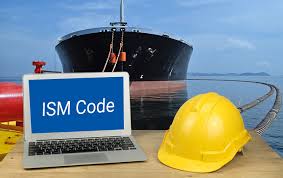
ISM Code Course Overview
The ISM (International Safety Management) Code course is designed to provide maritime professionals with an understanding of the ISM Code’s requirements and its application to safety management systems on board ships and within shipping companies. The course covers the principles of safety management, compliance with international regulations, and the implementation of effective safety and quality management practices.
Objectives
- Educate participants on the ISM Code and its objectives for safety management.
- Equip maritime professionals with the skills to develop, implement, and maintain Safety Management Systems (SMS).
- Ensure compliance with international safety regulations and improve overall safety standards on board ships and in shipping companies.
Course Content
-
Introduction to the ISM Code
- Overview of the ISM Code and its objectives.
- Key principles and requirements of the ISM Code.
- Importance of safety management in maritime operations.
-
Safety Management System (SMS)
- Development and structure of a Safety Management System.
- Key elements of SMS, including safety and environmental protection policies.
- Responsibilities and roles within the SMS framework.
-
Implementation of the ISM Code
- Procedures for implementing the ISM Code on ships and within organizations.
- Developing and documenting safety policies and procedures.
- Integration of SMS into daily operations and management practices.
-
Safety and Environmental Protection
- Measures for ensuring safety and environmental protection on board.
- Emergency preparedness and response plans.
- Risk assessment and mitigation strategies.
-
Internal Audits and Reviews
- Conducting internal audits of the SMS to ensure compliance and effectiveness.
- Developing audit plans, conducting audits, and reporting findings.
- Implementing corrective actions and continuous improvement.
-
Regulatory Compliance
- Understanding and complying with international maritime safety regulations.
- Preparing for and handling external audits and inspections.
- Keeping up-to-date with changes in regulations and industry standards.
-
Training and Documentation
- Training crew and staff on SMS procedures and safety practices.
- Documenting safety policies, procedures, and training records.
- Ensuring effective communication and documentation management.
-
Incident Investigation and Reporting
- Procedures for investigating safety incidents and accidents.
- Reporting requirements and analysis of incidents.
- Implementing lessons learned and corrective actions.
-
Management Review and Continuous Improvement
- Conducting management reviews of the SMS.
- Identifying areas for improvement and implementing changes.
- Promoting a culture of safety and continuous improvement.
-
Case Studies and Practical Applications
- Analysis of real-world examples and case studies related to SMS.
- Practical exercises and simulations to apply knowledge.
- Discussion of current trends and challenges in safety management.
Course Duration and Certification
- Duration: Typically 2 to 5 days, depending on the institution and course depth.
- Certification: Successful completion of the course awards a certification in ISM Code implementation and management, verifying proficiency in safety management practices.
Importance
- Regulatory Compliance: Ensures adherence to international safety management standards.
- Safety Management: Equips professionals with skills to develop and maintain effective safety management systems.
- Operational Efficiency: Enhances safety practices and operational efficiency on board ships and within organizations.
The ISM Code course provides maritime professionals with the expertise needed to effectively implement and manage Safety Management Systems, ensuring compliance with international regulations and enhancing overall safety and quality in maritime operations.
The following requirements are compulsory for class attendance and certificate approval.
- Seafarer’s Medical fitness certificate.
- Basic mandatory(STCW) Certificate.
- 2 Passport photograph.
- Valid means of Identification (NIN, INTERNATIONAL PASSPORT, VOTERS CARD SEAMAN BOOKLET ETC.)
- Receipts of payments
- 2 DAYS.
REGISTRATION
- Visit our office at Plot 10, 39th Street, DDPA Housing Estate, Ugborikoko Effurun-Warri, Delta State.
NOTE: Payment is done only at our office, and payment validates registration.
ADVANCE FIRE FIGHTING
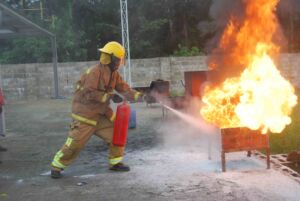
Advanced Fire Fighting Course Overview
The Advanced Fire Fighting course is designed to provide seafarers with comprehensive training in firefighting techniques and strategies, focusing on advanced methods for preventing, controlling, and extinguishing fires on board ships. This course is essential for those responsible for managing firefighting operations and ensuring the safety of the vessel and its crew.
Objectives
- Equip participants with advanced firefighting skills and knowledge.
- Prepare seafarers to manage and lead firefighting operations on board.
- Ensure compliance with international maritime safety regulations, particularly under the STCW Convention.
Course Content
-
Firefighting Principles and Theories
- Understanding the chemistry of fire and combustion.
- Fire classifications and the behavior of different types of fires.
- Heat transfer methods and their impact on fire spread.
-
Firefighting Equipment and Systems
- Detailed overview of firefighting equipment, including extinguishers, hoses, nozzles, and protective gear.
- Operation and maintenance of fixed firefighting systems such as sprinklers, CO2 systems, and foam systems.
- Use of fire detection and alarm systems.
-
Fire Prevention and Risk Assessment
- Identifying potential fire hazards on board.
- Conducting fire risk assessments and implementing preventive measures.
- Developing and maintaining fire safety plans.
-
Firefighting Strategies and Tactics
- Advanced firefighting techniques and tactics for different types of fires.
- Search and rescue operations in smoke-filled and confined spaces.
- Ventilation techniques and control of smoke and heat.
-
Leadership and Coordination
- Roles and responsibilities of firefighting team leaders.
- Effective communication and coordination during firefighting operations.
- Incident command systems and chain of command.
-
Emergency Response and Procedures
- Developing and implementing ship-specific emergency response plans.
- Conducting fire drills and emergency exercises.
- Evacuation procedures and use of life-saving appliances.
-
Human Factors in Firefighting
- Psychological and physical effects of firefighting on crew members.
- Stress management and maintaining situational awareness.
- Team dynamics and leadership under emergency conditions.
-
Practical Firefighting Exercises
- Hands-on training in advanced firefighting techniques.
- Simulated fire scenarios to practice coordination and response.
- Use of real firefighting equipment in controlled environments.
-
Fire Investigation and Reporting
- Procedures for investigating the cause of fires on board.
- Documentation and reporting of fire incidents.
- Implementing lessons learned to improve fire safety.
-
Regulatory Compliance
- Understanding international regulations and standards related to firefighting.
- Compliance with SOLAS and STCW requirements.
- Preparing for and handling inspections and audits.
Course Duration and Certification
- Duration: Typically 4 to 5 days, depending on the training provider and course structure.
- Certification: Successful completion of the course awards an Advanced Fire Fighting certificate, which is required for senior shipboard personnel under the STCW Convention.
Importance
- Enhanced Safety: Provides seafarers with advanced skills to effectively manage and combat fires on board, ensuring the safety of the vessel and crew.
- Regulatory Compliance: Ensures compliance with international maritime safety regulations and standards.
- Career Advancement: Necessary for career progression to senior shipboard positions with firefighting responsibilities.
The Advanced Fire Fighting course is crucial for maritime professionals responsible for firefighting operations, equipping them with the expertise needed to prevent, control, and extinguish fires on board ships effectively.
The following requirements are compulsory for class attendance and certificate approval.
- Seafarer’s Medical fitness certificate.
- Basic mandatory(STCW) Certificate.
- 2 Passport photograph.
- Valid means of Identification (NIN, INTERNATIONAL PASSPORT, VOTERS CARD SEAMAN BOOKLET ETC.)
- Receipts of payments
- NEW 3 DAYS
- RENEWAL 2 DAYS
REGISTRATION
- Visit our office at Plot 10, 39th Street, DDPA Housing Estate, Ugborikoko Effurun-Warri, Delta State.
NOTE: Payment is done only at our office, and payment validates registration.
MEDICAL FIRST AID

Medical First Aid Course Overview
The Medical First Aid course is designed to provide seafarers with the knowledge and skills required to administer first aid in medical emergencies at sea. This training is essential for ensuring the health and safety of crew members, enabling them to provide effective medical assistance until professional medical help can be obtained.
Objectives
- Equip participants with the skills to provide immediate and effective first aid.
- Prepare seafarers to handle medical emergencies on board ships.
- Ensure compliance with international maritime safety regulations, particularly under the STCW Convention.
Course Content
-
Basic First Aid Principles
- Introduction to first aid and its importance in maritime settings.
- Responsibilities of a first aider.
- Legal and ethical considerations in providing first aid.
-
Assessment and Management of Medical Emergencies
- Primary and secondary assessment of casualties.
- Identifying and managing life-threatening conditions.
- Prioritizing treatment and managing multiple casualties.
-
Cardiopulmonary Resuscitation (CPR)
- Techniques for performing CPR on adults, children, and infants.
- Use of automated external defibrillators (AEDs).
- Management of choking and airway obstructions.
-
Bleeding and Wound Management
- Control of external bleeding using direct pressure, bandages, and tourniquets.
- Management of internal bleeding.
- Treatment of various types of wounds, including cuts, abrasions, and punctures.
-
Burns and Scalds
- Assessment and classification of burns.
- Immediate first aid treatment for burns and scalds.
- Prevention of infection and further injury.
-
Fractures and Dislocations
- Recognition of fractures, dislocations, and sprains.
- Immobilization techniques and use of splints.
- Handling spinal injuries and maintaining spinal alignment.
-
Medical Conditions
- Management of common medical conditions, such as asthma, diabetes, and seizures.
- Recognizing and treating heart attacks, strokes, and allergic reactions.
- Administration of medication as per onboard protocols.
-
Environmental Injuries
- Treatment of hypothermia, heat exhaustion, and heat stroke.
- Management of marine stings, bites, and poisoning.
- First aid for drowning and near-drowning incidents.
-
Emergency Childbirth
- Basic knowledge of childbirth and complications.
- Immediate care for mother and newborn.
- Handling emergencies related to childbirth at sea.
-
Use of Medical Equipment
- Familiarization with onboard medical supplies and equipment.
- Proper use and maintenance of first aid kits.
- Use of communication equipment to seek medical advice.
-
Record Keeping and Reporting
- Documentation of medical incidents and treatments provided.
- Reporting requirements and procedures.
- Communicating with shore-based medical support.
-
Practical Exercises and Simulations
- Hands-on practice of first aid techniques.
- Simulated scenarios to apply knowledge and skills.
- Role-playing exercises to build confidence and competence.
Course Duration and Certification
- Duration: Typically 3 to 4 days, depending on the training provider and course structure.
- Certification: Successful completion of the course awards a Medical First Aid certificate, which is required for certain shipboard positions under the STCW Convention.
Importance
- Enhanced Safety: Provides seafarers with essential skills to manage medical emergencies, ensuring the well-being of the crew.
- Regulatory Compliance: Ensures compliance with international maritime safety regulations and standards.
- Career Advancement: Necessary for career progression to roles involving medical responsibilities on board.
The Medical First Aid course is crucial for maritime professionals, equipping them with the necessary skills to provide effective medical assistance in emergencies, thereby enhancing the safety and health of all crew members on board.
The following requirements are compulsory for class attendance and certificate approval.
- Seafarer’s Medical fitness certificate.
- Basic mandatory(STCW) Certificate.
- 2 Passport photograph.
- Valid means of Identification (NIN, INTERNATIONAL PASSPORT, VOTERS CARD SEAMAN BOOKLET ETC.)
- Receipts of payments
- 3 DAYS.
REGISTRATION
- Visit our office at Plot 10, 39th Street, DDPA Housing Estate, Ugborikoko Effurun-Warri, Delta State.
NOTE: Payment is done only at our office, and payment validates registration.
MEDICARE
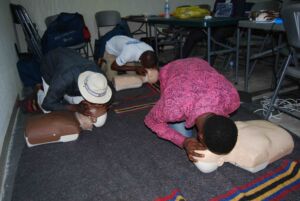
Medicare Overview
Medicare is a federal health insurance program in the United States primarily for individuals aged 65 and older, though it also covers some younger people with disabilities and individuals with End-Stage Renal Disease (ESRD). The program is administered by the Centers for Medicare & Medicaid Services (CMS).
Objectives
- Provide affordable health care to senior citizens and certain individuals with disabilities.
- Offer a range of medical services, including hospital care, medical services, and prescription drugs.
- Ensure access to necessary medical care while controlling costs for beneficiaries.
Components of Medicare
-
Medicare Part A (Hospital Insurance)
- Covers inpatient hospital stays, care in a skilled nursing facility, hospice care, and some home health care.
- Most people do not pay a premium for Part A if they or their spouse paid Medicare taxes while working.
-
Medicare Part B (Medical Insurance)
- Covers certain doctors’ services, outpatient care, medical supplies, and preventive services.
- Requires a monthly premium, which can vary based on income.
-
Medicare Part C (Medicare Advantage Plans)
- An alternative to Original Medicare (Parts A and B) offered by private companies approved by Medicare.
- Provides all Part A and Part B benefits and usually includes Part D (prescription drug coverage).
- Often offers additional benefits like vision, hearing, dental, and wellness programs.
-
Medicare Part D (Prescription Drug Coverage)
- Provides prescription drug coverage through Medicare-approved private insurers.
- Requires a monthly premium, which varies by plan and income.
- Helps lower the cost of prescription drugs and protect against higher costs in the future.
Enrollment
- Initial Enrollment Period (IEP): Starts three months before the month you turn 65 and ends three months after the month you turn 65.
- General Enrollment Period (GEP): January 1 to March 31 each year for those who did not sign up when first eligible.
- Special Enrollment Period (SEP): Available for individuals who qualify under special circumstances, such as losing other health coverage.
Costs
- Premiums: Vary based on the part of Medicare and income level.
- Deductibles and Copayments: Beneficiaries are responsible for certain out-of-pocket costs, which vary by plan.
- Late Enrollment Penalties: May apply for not enrolling in Parts B or D when first eligible without having other credible coverage.
Importance
- Healthcare Access: Ensures that senior citizens and eligible individuals with disabilities have access to necessary medical care.
- Financial Protection: Helps protect against high medical costs and provides financial stability in accessing healthcare.
- Comprehensive Coverage: Offers a wide range of medical services, from hospital stays to preventive services, helping to maintain overall health and well-being.
Medicare is a vital program providing health insurance to millions of Americans, ensuring they receive necessary medical care while managing healthcare costs. It is crucial for eligible individuals to understand their options, enroll on time, and select the best coverage to meet their healthcare needs.
The following requirements are compulsory for class attendance and certificate approval.
- Seafarer’s Medical fitness certificate.
- Basic mandatory(STCW) Certificate.
- 2 Passport photograph.
- Valid means of Identification (NIN, INTERNATIONAL PASSPORT, VOTERS CARD SEAMAN BOOKLET ETC.)
- Receipts of payments
- 5 DAYS.
REGISTRATION
- Visit our office at Plot 10, 39th Street, DDPA Housing Estate, Ugborikoko Effurun-Warri, Delta State.
NOTE: Payment is done only at our office, and payment validates registration.
GLOBAL MARITIME DISTRESS AND SAFETY SYSTEM(GMDSS)
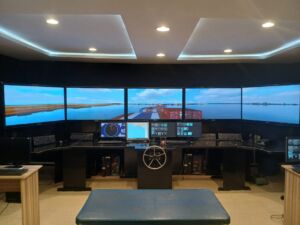
Global Maritime Distress and Safety System (GMDSS) Course Overview
The Global Maritime Distress and Safety System (GMDSS) course is designed to train seafarers in the use of the GMDSS equipment and procedures, ensuring they are capable of managing communications in distress and safety situations at sea. The GMDSS is an internationally agreed-upon set of safety procedures, types of equipment, and communication protocols used to increase safety and make it easier to rescue distressed ships, boats, and aircraft.
Objectives
- Train participants to operate GMDSS equipment effectively.
- Ensure understanding of international maritime communication regulations.
- Prepare seafarers to handle distress and safety communication procedures.
Course Content
-
Introduction to GMDSS
- Overview of the GMDSS and its purpose.
- History and development of GMDSS.
- Components and functions of the GMDSS.
-
GMDSS Regulations and Requirements
- International regulations and SOLAS (Safety of Life at Sea) Convention requirements.
- The role of the International Maritime Organization (IMO) in GMDSS.
- Certification and licensing requirements for GMDSS operators.
-
GMDSS Equipment
- Types of GMDSS equipment: VHF, MF/HF radio systems, Inmarsat, EPIRBs, SARTs, NAVTEX.
- Installation, operation, and maintenance of GMDSS equipment.
- Power sources and battery maintenance for GMDSS equipment.
-
Distress, Urgency, and Safety Communications
- Procedures for sending distress alerts and messages.
- Handling urgency and safety communications.
- Communication protocols and formats for distress signals.
-
Search and Rescue (SAR) Operations
- Role of GMDSS in search and rescue operations.
- Coordination with rescue coordination centers (RCCs) and other SAR authorities.
- Use of GMDSS equipment in SAR scenarios.
-
Digital Selective Calling (DSC)
- Principles and operation of DSC.
- Procedures for sending and receiving DSC distress alerts.
- Use of DSC in routine, urgency, and safety communications.
-
Satellite Communications
- Overview of Inmarsat systems and services.
- Operating procedures for Inmarsat terminals.
- Role of satellites in GMDSS.
-
Radio Communication Procedures
- Standard maritime communication procedures and protocols.
- Use of the phonetic alphabet and standard marine communication phrases.
- Maintaining a communication log and record-keeping.
-
Navigational Warnings and Weather Information
- Receiving and interpreting NAVTEX messages.
- Accessing maritime safety information (MSI) broadcasts.
- Understanding weather forecasts and navigational warnings.
-
Practical Exercises and Simulations
- Hands-on training with GMDSS equipment.
- Simulated distress and safety communication scenarios.
- Practical exercises to reinforce theoretical knowledge.
Course Duration and Certification
- Duration: Typically 5 to 10 days, depending on the training provider and course structure.
- Certification: Successful completion of the course awards a GMDSS General Operator’s Certificate (GOC) or Restricted Operator’s Certificate (ROC), depending on the level of training and the type of equipment covered.
Importance
- Safety: Ensures seafarers are proficient in using GMDSS equipment to enhance safety at sea.
- Regulatory Compliance: Meets international maritime communication standards and SOLAS requirements.
- Effective Communication: Enhances the ability to manage distress, urgency, and safety communications efficiently.
The GMDSS course is essential for maritime professionals, equipping them with the skills to operate critical communication equipment and manage distress and safety communications, thereby contributing to the overall safety and security of maritime operations.
The following requirements are compulsory for class attendance and certificate approval.
- Seafarer’s Medical fitness certificate.
- Basic mandatory(STCW) Certificate.
- 2 Passport photograph.
- Valid means of Identification (NIN, INTERNATIONAL PASSPORT, VOTERS CARD SEAMAN BOOKLET ETC.)
- Receipts of payments
- NEW 10 DAYS
- RENEWAL 5 DAYS
REGISTRATION
- Visit our office at Plot 10, 39th Street, DDPA Housing Estate, Ugborikoko Effurun-Warri, Delta State.
NOTE: Payment is done only at our office, and payment validates registration.
ARPA/RADAR
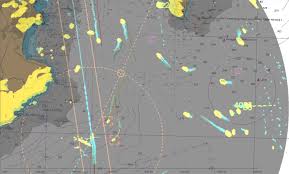
ARPA/RADAR Course Overview
The ARPA (Automatic Radar Plotting Aids) and RADAR course is designed to provide seafarers with the knowledge and skills necessary to operate RADAR and ARPA systems efficiently. These systems are crucial for navigation and collision avoidance, enhancing maritime safety by providing accurate and real-time information about the vessel’s surroundings.
Objectives
- Train participants in the effective use of RADAR and ARPA for safe navigation.
- Ensure understanding of the principles, operation, and interpretation of RADAR and ARPA data.
- Prepare seafarers to manage collision avoidance and navigational safety using these systems.
Course Content
-
Introduction to RADAR
- Overview of RADAR technology and its applications in maritime navigation.
- Principles of RADAR operation and wave propagation.
- Types of RADAR systems used in maritime operations.
-
RADAR Equipment and Operation
- Components of RADAR systems, including antennas, displays, and controls.
- Installation, calibration, and maintenance of RADAR equipment.
- Power sources and backup systems for RADAR.
-
RADAR Display and Interpretation
- Understanding RADAR displays and interpreting the data.
- Identifying and distinguishing between different types of targets.
- Use of RADAR in various weather conditions and sea states.
-
Introduction to ARPA
- Overview of ARPA technology and its role in maritime navigation.
- Principles of ARPA operation and target tracking.
- Integration of ARPA with RADAR systems.
-
ARPA Equipment and Operation
- Components of ARPA systems, including tracking algorithms and display units.
- Installation, calibration, and maintenance of ARPA equipment.
- Use of ARPA for automatic plotting and target tracking.
-
Collision Avoidance with RADAR and ARPA
- Principles and techniques for collision avoidance.
- Use of RADAR and ARPA data to make informed navigational decisions.
- Understanding and applying the International Regulations for Preventing Collisions at Sea (COLREGs).
-
Advanced RADAR and ARPA Features
- Use of guard zones, alarms, and other advanced features.
- Understanding limitations and potential errors in RADAR and ARPA data.
- Enhancing situational awareness through advanced system features.
-
Navigational Safety and Efficiency
- Enhancing navigational safety using RADAR and ARPA.
- Use of RADAR and ARPA in congested and restricted waters.
- Integrating RADAR and ARPA with other navigational systems, such as ECDIS and AIS.
-
Practical Exercises and Simulations
- Hands-on training with RADAR and ARPA equipment.
- Simulated scenarios to practice collision avoidance and target tracking.
- Practical exercises to reinforce theoretical knowledge and skills.
-
Regulatory Compliance and Standards
- Understanding international regulations and standards for RADAR and ARPA use.
- Compliance with SOLAS and STCW requirements.
- Preparing for and handling inspections and audits.
Course Duration and Certification
- Duration: Typically 5 to 10 days, depending on the training provider and course structure.
- Certification: Successful completion of the course awards a certificate of proficiency in RADAR and ARPA operation, which is required for certain shipboard positions under the STCW Convention.
Importance
- Safety: Enhances the ability to navigate safely and avoid collisions, contributing to overall maritime safety.
- Regulatory Compliance: Ensures compliance with international maritime regulations and standards.
- Operational Efficiency: Improves navigational efficiency and decision-making using advanced RADAR and ARPA features.
The ARPA/RADAR course is essential for maritime professionals, equipping them with the knowledge and skills needed to operate these critical navigation systems effectively, thereby enhancing safety and efficiency in maritime operations.
The following requirements are compulsory for class attendance and certificate approval.
- Seafarer’s Medical fitness certificate.
- Basic mandatory(STCW) Certificate.
- 2 Passport photograph.
- Valid means of Identification (NIN, INTERNATIONAL PASSPORT, VOTERS CARD SEAMAN BOOKLET ETC.)
- Receipts of payments
- 5 DAYS.
REGISTRATION
- Visit our office at Plot 10, 39th Street, DDPA Housing Estate, Ugborikoko Effurun-Warri, Delta State.
NOTE: Payment is done only at our office, and payment validates registration.
OFFICER OF THE WATCH(OOW)
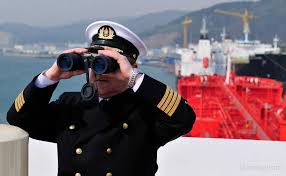
The Officer of the Watch (OOW) course is a specialized training program designed to equip maritime professionals with the knowledge and skills necessary to serve as an officer on a vessel. The course typically covers a wide range of topics related to navigation, safety, and vessel operations. Here is an overview of the key components often included in an OOW course:
1. Navigation
- Chartwork: Learning to read and interpret nautical charts, plot courses, and determine positions.
- Electronic Navigation: Use of GPS, radar, ECDIS (Electronic Chart Display and Information System), and other electronic navigational aids.
- Celestial Navigation: Use of celestial bodies for navigation, including the use of sextants and almanacs.
- Tides and Currents: Understanding tidal patterns and currents and their effects on navigation.
2. Safety and Seamanship
- Rules of the Road (COLREGS): International regulations for preventing collisions at sea.
- Safety Equipment: Knowledge of life-saving appliances and firefighting equipment.
- Emergency Procedures: Response to various emergencies such as man overboard, fire, flooding, and abandon ship.
3. Communications
- VHF and HF Radio Operations: Use of maritime radio for communication.
- GMDSS (Global Maritime Distress and Safety System): Understanding and operating GMDSS equipment for distress and safety communications.
- Bridge Resource Management (BRM): Effective communication and teamwork on the bridge.
4. Watchkeeping Duties
- Watchkeeping Principles: Duties and responsibilities of the officer on watch, including lookout duties, logbook maintenance, and watch handover procedures.
- Bridge Procedures: Standard operating procedures for the bridge, including navigational watch, anchoring, and docking.
5. Meteorology
- Weather Systems: Understanding weather patterns and systems.
- Weather Forecasting: Interpreting weather forecasts and meteorological data.
- Effect of Weather on Navigation: Impact of different weather conditions on vessel operations.
6. Ship Operations
- Cargo Operations: Basics of cargo handling and stowage.
- Ship Handling: Principles of ship maneuvering, including berthing, unberthing, and anchoring.
- Engine Room Knowledge: Basic understanding of engine room operations and machinery.
7. Regulations and Compliance
- Maritime Law: Understanding international maritime conventions and regulations.
- ISM Code: Familiarity with the International Safety Management Code.
- Port State Control: Inspections and compliance with port state requirements.
Course Structure
The OOW course typically includes both theoretical and practical components:
- Classroom Lectures: Covering the theoretical aspects of navigation, safety, and maritime regulations.
- Simulation Training: Using bridge simulators to practice navigation and watchkeeping in a controlled environment.
- Sea Time: Practical experience on board a vessel, often required to obtain the necessary sea service for certification.
Certification
Upon successful completion of the OOW course and meeting the sea service requirements, candidates are eligible to obtain an Officer of the Watch Certificate of Competency (CoC), which allows them to serve as an officer on a commercial vessel.
Additional Requirements
In addition to the course itself, candidates often need to complete ancillary courses such as:
- Basic Safety Training: Including personal survival techniques, fire prevention and firefighting, elementary first aid, and personal safety and social responsibilities.
- Proficiency in Survival Craft and Rescue Boats: Training in the use of lifeboats and rescue boats.
- Advanced Firefighting: Techniques for fighting fires on board.
Conclusion
The OOW course is a comprehensive training program essential for anyone aspiring to take on the responsibilities of an officer on a vessel. It provides the foundational knowledge and skills required to ensure the safety and efficiency of maritime operations.
ORIGINAL/PHOTOCOPY OF THE FOLLOWING.
- Admission Form
- Eligibility from NIMASA and Receipt of Payment
- ND in Marine Engineering, Nautical Science or Associate in Marine Engineering & Associate in Nautical Science
- Certificate of Proficiency (Watch-Keeping/Able Seafarer in Engine or Deck)
- ISPS Rating (Security awareness or designated security duties)
- Basic Mandatory
- Seaman Discharge Book (duly signed by shipping master & master/captain)
- Sea Service Testimonials
- Valid Service Testimonials
- Four (4) recent Passport Photographs
- Birth Certificate or Sworn affidavit
- State of Origin
- 6 Months
REGISTRATION
- Visit our office at Plot 10, 39th Street, DDPA Housing Estate, Ugborikoko Effurun-Warri, Delta State.
NOTE: Payment is done only at our office, and payment validates registration.
ASSOCIATE

An Associate Degree program for maritime studies typically offers courses tailored to prepare students for careers as either deck officers or engineering officers. Below is an overview of the courses typically included in Associate Degree programs for both pathways.
Associate Degree in Maritime Studies – Deck Officer Track
1. Introduction to Maritime Studies
- Overview of the maritime industry
- Roles and responsibilities of maritime professionals
2. Navigation and Seamanship
- Basic and advanced navigation techniques
- Use of nautical charts and navigation instruments
- Coastal and celestial navigation
3. Marine Safety and Emergency Procedures
- Safety regulations and best practices
- Emergency response and firefighting
- Personal survival techniques
4. Ship Operations and Management
- Shipboard operations and management
- Cargo handling and stowage
- Ship stability and dynamics
5. Marine Meteorology
- Weather systems and forecasting
- Impact of weather on navigation
6. Maritime Law and Regulations
- International maritime conventions
- Collision regulations (COLREGS)
- Port state control and inspections
7. Bridge Resource Management (BRM)
- Teamwork and communication on the bridge
- Watchkeeping principles and procedures
8. Electronic Navigation Systems
- GPS, radar, ECDIS
- Use and maintenance of electronic navigation aids
Practical Training
- Sea training and internships on board vessels
- Simulation training using bridge simulators
Associate Degree in Maritime Studies – Engineering Officer Track
1. Introduction to Marine Engineering
- Overview of marine engineering systems
- Roles and responsibilities of marine engineers
2. Marine Machinery and Systems
- Operation and maintenance of propulsion systems
- Auxiliary machinery and systems
3. Marine Electrical Systems
- Electrical circuits and systems on ships
- Maintenance and troubleshooting of electrical equipment
4. Thermodynamics and Fluid Mechanics
- Principles of thermodynamics
- Fluid mechanics applications in marine engineering
5. Engine Room Operations and Watchkeeping
- Engine room procedures and protocols
- Watchkeeping duties and responsibilities
6. Marine Safety and Emergency Procedures
- Safety regulations and best practices
- Emergency response and firefighting
- Personal survival techniques
7. Marine Environmental Protection
- Environmental regulations and compliance
- Pollution prevention and control measures
8. Maintenance and Repair Techniques
- Routine and preventive maintenance
- Repair of machinery and systems
Practical Training
- Sea training and internships in engine rooms
- Simulation training using engine room simulators
Conclusion
Associate Degree programs in maritime studies provide a comprehensive foundation for careers as deck officers or engineering officers. They combine theoretical knowledge with practical training to ensure graduates are well-prepared for the challenges of working on board vessels. The specific courses and training components may vary depending on the institution and regulatory requirements.
4o
ORIGINAL/PHOTOCOPY OF THE FOLLOWING.
- Certificate of Proficiency (Watch keeping, QM), or B.Sc, HND, OND.
- Mandatory Certificate
- Medical Certificate
- Discharge Certificate (With minimum 18months experience on board).
- Age Declaration
- SSCE/WAEC Certificate.
- Two (2) passport Photograph
- Local Govt Identification
- International Passport
- Company’s Sea Testimonial.
- 6 Months
REGISTRATION
- Visit our office at Plot 10, 39th Street, DDPA Housing Estate, Ugborikoko Effurun-Warri, Delta State.
NOTE: Payment is done only at our office, and payment validates registration.
BRIDGE RESOURCE MANAGEMENT(BRM)
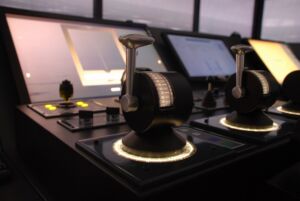
Bridge Resource Management (BRM) is a critical course designed to enhance the safety and efficiency of vessel operations by improving the management and use of all available resources on the bridge. Here is an overview of the key components typically included in a BRM course:
Course Objectives
- Improve decision-making processes on the bridge.
- Enhance communication and teamwork among bridge personnel.
- Foster a culture of safety and situational awareness.
- Optimize the use of all available resources, including human, technical, and procedural.
Key Topics Covered
1. Principles of Bridge Resource Management
- Definition and objectives of BRM.
- The importance of resource management in maritime operations.
2. Human Factors and Teamwork
- The role of human factors in bridge operations.
- Effective team building and leadership on the bridge.
- Communication techniques and barriers.
- Conflict resolution and decision-making processes.
3. Situational Awareness
- Maintaining situational awareness on the bridge.
- Techniques for monitoring and assessing the navigational environment.
- Risk assessment and management.
4. Effective Communication
- Standard communication protocols and practices.
- Use of closed-loop communication to ensure clarity and understanding.
- Verbal and non-verbal communication skills.
5. Leadership and Decision Making
- Leadership styles and their impact on bridge operations.
- Decision-making models and strategies.
- Managing stress and fatigue in high-pressure situations.
6. Resource Management
- Optimizing the use of bridge equipment and technology.
- Coordination with other departments and external entities (e.g., engine room, shore stations).
- Efficient watchkeeping and workload management.
7. Case Studies and Incident Analysis
- Review of maritime incidents and accidents related to BRM failures.
- Lessons learned and best practices from real-world cases.
8. Practical Exercises and Simulation Training
- Scenario-based training using bridge simulators.
- Role-playing exercises to practice BRM principles.
- Evaluation and feedback sessions to reinforce learning.
Practical Training Components
- Simulator Training: Hands-on practice in bridge simulators, replicating real-life scenarios to apply BRM principles.
- Role-Playing: Exercises to practice communication, teamwork, and decision-making in a controlled environment.
- Case Study Analysis: Reviewing and analyzing real maritime incidents to understand the application of BRM.
Learning Outcomes
Upon completion of the BRM course, participants should be able to:
- Apply BRM principles to enhance bridge operations.
- Communicate effectively and work as a cohesive team.
- Maintain high levels of situational awareness.
- Make informed and timely decisions under pressure.
- Use bridge equipment and resources efficiently.
- Recognize and mitigate human factors that can impact safety.
Certification
Participants who successfully complete the BRM course typically receive a certificate of completion, which may be a requirement for certain maritime positions and certifications.
Conclusion
The Bridge Resource Management course is essential for all bridge officers and crew members. It equips them with the skills needed to operate safely and efficiently, ensuring the safety of the vessel, its crew, and the environment. The course emphasizes the importance of teamwork, effective communication, and situational awareness in maritime operations.
The following requirements are compulsory for class attendance and certificate approval.
- Seafarer’s Medical fitness certificate.
- Basic mandatory(STCW) Certificate.
- 2 Passport photograph.
- Valid means of Identification (NIN, INTERNATIONAL PASSPORT, VOTERS CARD SEAMAN BOOKLET ETC.)
- Receipts of payments
- 3 DAYS.
REGISTRATION
- Visit our office at Plot 10, 39th Street, DDPA Housing Estate, Ugborikoko Effurun-Warri, Delta State.
NOTE: Payment is done only at our office, and payment validates registration.
ELECTRONIC CHART DISPLAY AND INFORMATION SYSTEM(ECDIS)
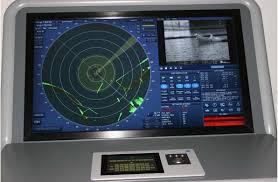
The Electronic Chart Display and Information System (ECDIS) course is designed to train mariners in the use and operation of ECDIS, a crucial navigational tool that enhances safety and efficiency in maritime operations. Here’s an overview of the key components typically included in an ECDIS course:
Course Objectives
- Understand the principles and functionality of ECDIS.
- Gain proficiency in the use of ECDIS for safe navigation.
- Learn to integrate ECDIS with other navigational tools and systems.
- Ensure compliance with international regulations and standards related to ECDIS.
Key Topics Covered
1. Introduction to ECDIS
- Overview of ECDIS and its importance in modern navigation.
- Components and hardware of an ECDIS system.
2. Regulations and Standards
- International Maritime Organization (IMO) requirements for ECDIS.
- International Hydrographic Organization (IHO) standards.
- SOLAS (Safety of Life at Sea) requirements.
3. ECDIS Hardware and Software
- Different types of ECDIS systems and their components.
- Installation, setup, and configuration of ECDIS.
4. Electronic Navigational Charts (ENCs)
- Types and sources of electronic charts (ENCs and RNCs).
- Updating and maintaining electronic charts.
- Chart datums and projections.
5. ECDIS Functions and Features
- Basic and advanced navigational functions.
- Route planning and monitoring.
- Safety features such as alarms and alerts.
- Integration with other navigational systems (GPS, AIS, radar).
6. Navigational Operations with ECDIS
- Position fixing and course plotting.
- Passage planning and execution.
- Navigational watchkeeping with ECDIS.
7. Safety and Risk Management
- Safety settings and parameters in ECDIS.
- Use of safety contours and depth areas.
- Collision avoidance and anti-grounding functions.
8. System Limitations and Failures
- Understanding the limitations of ECDIS.
- Procedures for handling ECDIS failures.
- Backup arrangements and traditional navigation methods.
9. Case Studies and Practical Exercises
- Analysis of incidents and accidents involving ECDIS.
- Real-world scenarios and practical exercises.
- Simulator training to apply ECDIS knowledge.
Practical Training Components
- Simulator Training: Hands-on practice using ECDIS simulators to replicate real-life scenarios.
- Chart Exercises: Tasks involving route planning, monitoring, and navigation using electronic charts.
- System Setup and Configuration: Practical exercises in setting up and configuring ECDIS equipment.
Learning Outcomes
Upon completion of the ECDIS course, participants should be able to:
- Operate ECDIS systems confidently and competently.
- Plan and monitor voyages using ECDIS.
- Integrate ECDIS with other navigational tools and systems.
- Recognize and respond to ECDIS alarms and alerts.
- Ensure compliance with relevant regulations and standards.
- Handle ECDIS malfunctions and revert to traditional navigation methods when necessary.
Certification
Participants who successfully complete the ECDIS course typically receive a certificate of proficiency, which is often required for officer certification and to comply with international maritime regulations.
Conclusion
The ECDIS course is essential for modern mariners, providing them with the skills and knowledge to use this critical navigational tool effectively. The course ensures that mariners are prepared to integrate ECDIS into their daily operations, enhancing the safety and efficiency of vessel navigation.
The following requirements are compulsory for class attendance and certificate approval.
- Seafarer’s Medical fitness certificate.
- Basic mandatory(STCW) Certificate.
- 2 Passport photograph.
- Valid means of Identification (NIN, INTERNATIONAL PASSPORT, VOTERS CARD SEAMAN BOOKLET ETC.)
- Receipts of payments
- 5 DAYS.
REGISTRATION
- Visit our office at Plot 10, 39th Street, DDPA Housing Estate, Ugborikoko Effurun-Warri, Delta State.
NOTE: Payment is done only at our office, and payment validates registration.
PROFICIENCY IN SURVIVAL CRAFT AND RESCUE BOAT(PSCRB)

The Proficiency in Survival Craft and Rescue Boat (PSCRB) course is designed to provide mariners with the necessary skills and knowledge to handle and operate survival craft and rescue boats during emergencies. This course is essential for crew members designated to take charge of such craft. Here’s an overview of the key components typically included in a PSCRB course:
Course Objectives
- Equip mariners with the skills to safely operate and manage survival craft and rescue boats.
- Ensure participants are proficient in the use of life-saving appliances and survival techniques.
- Prepare mariners to handle emergency situations, including launching and recovering survival craft and rescue boats.
Key Topics Covered
1. Introduction to Survival Craft and Rescue Boats
- Types of survival craft (lifeboats, liferafts) and rescue boats.
- Design, construction, and equipment of survival craft and rescue boats.
- Regulations and standards governing survival craft and rescue boat operations.
2. Launching and Recovery Operations
- Procedures for launching survival craft and rescue boats.
- Use of launching appliances and mechanisms.
- Safe recovery of survival craft and rescue boats.
3. Handling and Operation
- Rowing, steering, and maneuvering survival craft and rescue boats.
- Use of engines and sail on survival craft.
- Operation in various sea conditions.
4. Emergency Procedures and Drills
- Preparation and readiness for emergencies.
- Conducting abandonment drills and survival craft operations.
- Coordination and communication during emergencies.
5. Survival Techniques and Equipment
- Use of personal protective equipment (PPE) and life-saving appliances.
- Techniques for maximizing survival in different conditions.
- Signaling and communication equipment for survival situations.
6. First Aid and Medical Care
- Basic first aid techniques for survival situations.
- Treatment of common injuries and medical conditions in survival craft.
- Use of first aid kits and medical supplies.
7. Search and Rescue (SAR) Operations
- Coordination with SAR services and other vessels.
- Techniques for locating and rescuing survivors.
- Use of rescue equipment and procedures for safe transfer of survivors.
8. Maintenance and Inspection
- Routine maintenance and inspection of survival craft and rescue boats.
- Ensuring readiness and serviceability of equipment.
- Reporting and documenting maintenance activities.
Practical Training Components
- Launching and Recovering Drills: Hands-on practice with launching and recovering survival craft and rescue boats.
- Operation and Handling: Practical exercises in rowing, steering, and maneuvering craft.
- Survival Techniques: Training in the use of life-saving appliances and survival strategies.
- Emergency Drills: Simulated emergency scenarios to practice coordination and response.
Learning Outcomes
Upon completion of the PSCRB course, participants should be able to:
- Operate survival craft and rescue boats during emergencies.
- Launch and recover survival craft safely and efficiently.
- Use life-saving equipment and apply survival techniques.
- Provide basic first aid and medical care in survival situations.
- Coordinate with SAR services and other vessels for effective rescue operations.
- Maintain and inspect survival craft and rescue boats to ensure readiness.
Certification
Participants who successfully complete the PSCRB course typically receive a certificate of proficiency, which is often required for certain positions on board ships and for compliance with international maritime regulations.
Conclusion
The Proficiency in Survival Craft and Rescue Boat course is essential for mariners tasked with the responsibility of handling and operating survival craft and rescue boats. The course ensures that participants are well-prepared to manage emergency situations, enhancing the overall safety and preparedness of the vessel’s crew.
The following requirements are compulsory for class attendance and certificate approval.
- Seafarer’s Medical fitness certificate.
- Basic mandatory(STCW) Certificate.
- 2 Passport photograph.
- Valid means of Identification (NIN, INTERNATIONAL PASSPORT, VOTERS CARD SEAMAN BOOKLET ETC.)
- Receipts of payments
- NEW 5 DAYS
- RENEWAL 3 DAYS
REGISTRATION
- Visit our office at Plot 10, 39th Street, DDPA Housing Estate, Ugborikoko Effurun-Warri, Delta State.
NOTE: Payment is done only at our office, and payment validates registration.
HUMAN ELEMENT LEADERSHIP AND MANAGEMENT(HELM)

The Human Element Leadership and Management (HELM) course is designed to enhance the leadership and managerial skills of maritime professionals. It focuses on the human element in maritime operations, emphasizing effective leadership, teamwork, and management practices. Here’s an overview of the key components typically included in a HELM course:
Course Objectives
- Develop leadership and management skills among maritime professionals.
- Improve understanding of the human element in maritime operations.
- Enhance communication, teamwork, and decision-making abilities.
- Foster a safety culture and effective resource management on board.
Key Topics Covered
1. Introduction to the Human Element
- Definition and significance of the human element in maritime operations.
- Understanding human behavior and performance.
- Impact of human factors on safety and efficiency.
2. Leadership Principles
- Characteristics of effective leaders.
- Leadership styles and their application in maritime settings.
- Building trust and motivation among crew members.
3. Teamwork and Collaboration
- Principles of effective teamwork.
- Strategies for fostering a collaborative work environment.
- Managing team dynamics and conflict resolution.
4. Communication Skills
- Importance of clear and effective communication.
- Techniques for improving verbal and non-verbal communication.
- Barriers to communication and how to overcome them.
5. Decision Making and Problem Solving
- Decision-making models and processes.
- Analytical and critical thinking skills.
- Techniques for effective problem-solving and risk assessment.
6. Resource Management
- Principles of Bridge Resource Management (BRM) and Engine Room Resource Management (ERRM).
- Efficient use of available resources, including human, technical, and informational.
- Strategies for workload management and stress reduction.
7. Stress and Fatigue Management
- Understanding the effects of stress and fatigue on performance.
- Techniques for managing stress and preventing fatigue.
- Implementing rest and work schedules to ensure crew well-being.
8. Safety Culture and Human Error
- Promoting a safety culture on board.
- Understanding and mitigating human error.
- Strategies for continuous improvement in safety practices.
9. Regulatory Framework
- International regulations and standards related to human element, leadership, and management.
- Compliance with IMO requirements and STCW (Standards of Training, Certification, and Watchkeeping) conventions.
10. Case Studies and Practical Exercises
- Analysis of maritime incidents and accidents involving human factors.
- Lessons learned and best practices.
- Practical exercises to apply leadership and management skills in simulated scenarios.
Practical Training Components
- Role-Playing and Simulations: Engaging in scenarios to practice leadership, teamwork, and decision-making.
- Group Discussions and Workshops: Collaborative activities to enhance understanding and application of course concepts.
- Case Study Analysis: Reviewing real-world incidents to learn from past experiences and apply best practices.
Learning Outcomes
Upon completion of the HELM course, participants should be able to:
- Demonstrate effective leadership and management skills.
- Foster a positive and collaborative team environment.
- Communicate clearly and effectively with crew members.
- Make informed and timely decisions in various situations.
- Manage resources efficiently to enhance safety and performance.
- Understand and mitigate the impact of human factors on maritime operations.
- Promote a safety culture and continuous improvement on board.
Certification
Participants who successfully complete the HELM course typically receive a certificate of proficiency, which may be required for certain leadership positions on board ships and for compliance with international maritime regulations.
Conclusion
The Human Element Leadership and Management course is essential for maritime professionals seeking to enhance their leadership and management capabilities. The course emphasizes the importance of the human element in maritime operations, providing participants with the skills and knowledge necessary to lead effectively, manage resources efficiently, and promote a culture of safety and excellence on board.
The following requirements are compulsory for class attendance and certificate approval.
- Seafarer’s Medical fitness certificate.
- Basic mandatory(STCW) Certificate.
- 2 Passport photograph.
- Valid means of Identification (NIN, INTERNATIONAL PASSPORT, VOTERS CARD SEAMAN BOOKLET ETC.)
- Receipts of payments
- 3 DAYS.
REGISTRATION
- Visit our office at Plot 10, 39th Street, DDPA Housing Estate, Ugborikoko Effurun-Warri, Delta State.
NOTE: Payment is done only at our office, and payment validates registration.
SHIP COOKS TRAINING

The Ship Cooks course is designed to provide maritime professionals with the skills and knowledge necessary to prepare and manage food services on board a vessel. This course covers various aspects of culinary arts, hygiene, and food safety specific to maritime environments. Here’s an overview of the key components typically included in a Ship Cooks course:
Course Objectives
- Equip participants with the skills to prepare and manage meals for the crew and passengers.
- Ensure understanding of food safety, hygiene, and nutrition in a maritime setting.
- Develop competence in managing galley operations and maintaining high standards of cleanliness and safety.
Key Topics Covered
1. Introduction to Shipboard Catering
- Roles and responsibilities of a ship cook.
- Overview of galley operations and equipment.
- Importance of maintaining a well-organized and efficient galley.
2. Food Preparation and Cooking Techniques
- Basic culinary skills, including chopping, cooking methods, and presentation.
- Preparation of a variety of meals, including breakfast, lunch, dinner, and special diets.
- Techniques for managing portion sizes and meal planning.
3. Food Safety and Hygiene
- Principles of food safety and hygiene.
- Procedures for safe handling, storage, and preparation of food.
- Prevention of foodborne illnesses and contamination.
- Cleaning and sanitizing procedures for galley equipment and utensils.
4. Nutritional Requirements and Meal Planning
- Understanding nutritional needs for different types of diets (e.g., balanced diets, special dietary needs).
- Planning meals to meet dietary requirements and preferences.
- Managing food supplies and minimizing waste.
5. Galley Management and Organization
- Inventory management and stock control.
- Ordering and receiving supplies.
- Maintaining records and documentation related to food preparation and inventory.
6. Emergency Procedures and First Aid
- Basic first aid for common kitchen injuries.
- Procedures for handling and reporting accidents in the galley.
- Emergency response for fire and other incidents in the galley.
7. Compliance with Maritime Regulations
- International Maritime Organization (IMO) requirements for shipboard catering.
- Compliance with Maritime Labour Convention (MLC) regulations regarding food and accommodation.
- Understanding and adhering to relevant health and safety regulations.
8. Cultural and Dietary Considerations
- Catering to diverse cultural and dietary preferences.
- Handling special dietary requirements and food allergies.
- Providing balanced and appealing meals for a multicultural crew.
9. Practical Training and Assessments
- Hands-on training in food preparation and cooking techniques.
- Practical exercises in meal planning, inventory management, and galley organization.
- Assessments to evaluate competence and readiness for shipboard catering duties.
Practical Training Components
- Cooking Exercises: Practical sessions for preparing and cooking various types of meals.
- Galley Operations: Training in the use and maintenance of galley equipment.
- Hygiene and Safety Practices: Hands-on practice with cleaning, sanitizing, and managing food safety.
Learning Outcomes
Upon completion of the Ship Cooks course, participants should be able to:
- Prepare and cook a variety of meals to high standards.
- Manage galley operations efficiently and safely.
- Ensure food safety and hygiene are maintained at all times.
- Plan and manage meals to meet nutritional requirements and dietary preferences.
- Handle inventory and supplies effectively.
- Respond appropriately to emergencies and first aid situations in the galley.
Certification
Participants who successfully complete the Ship Cooks course typically receive a certificate of proficiency, which is often required for positions as ship cooks and for compliance with international maritime regulations.
Conclusion
The Ship Cooks course is essential for maritime professionals responsible for food preparation and catering on board vessels. It ensures that participants are equipped with the culinary skills, knowledge of food safety, and management abilities needed to provide high-quality meals and maintain a well-organized galley. The course emphasizes practical training and adherence to safety and hygiene standards, which are crucial for successful shipboard catering.
